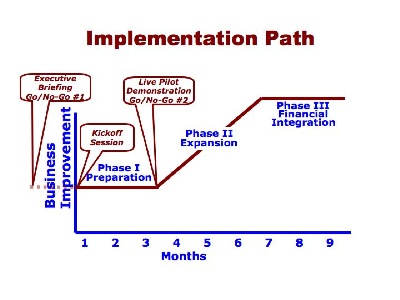




Our Implementation Process
The technical part of implementing Executive S&OP is straightforward and simple. But there’s a paradox here: even though this process itself is very straightforward and simple to understand, it is difficult to implement. Here’s why:
• It’s a new process for the company. It is not an extension of past
experience. It’s not doing what you do better; it’s doing something
different to be better.
• A new process means change: people changing some aspects of how they
do their jobs. This results in risk for the organization and discomfort for
the people.
• This change cannot be done without the sponsorship and leadership of top
management, and these people are usually very busy. When they do get
committed, however, they expect progress quickly and consistently. If this
rapid, consistent progress doesn’t happen, the effort will stall out and
almost certainly die.
• In order to address all of this, people need a solid understanding of the
process and the benefits it can provide in order to willingly and
enthusiastically make the necessary changes.
Keys to Success...
So it’s hard to do this right. The good news is that when you implement it, you don’t need to reinvent the wheel. Over the last twenty years or so, through trial and error, we’ve learned how to do it right – every time. Today, we see the keys to success more clearly than ever:
• Develop a solid understanding of what it is and what it will take to make it
work – before you get started. Particularly an understanding of the need
for change at all levels.
• Use a pilot approach to allow for rapid learning in a safe environment.
• Understand that there will be a learning curve and that you’ll be good
before you’re excellent
• Remember that people are the key to success in this venture. Your
success will hinge almost totally on the quality of the change
management processes employed.
• Be sure to have an S&OP Expert on board; from within or from the
outside. See the "What is an S&OP Expert?" page for further explanation.
For almost all of the companies that we’ve assisted in implementing Executive S&OP, benefits come sooner than six months. Some people call these ‘unintended benefits’ because they’re byproducts of people just beginning to communicate and work together better.
Further, once the pilot becomes operational, people begin to see things that they wouldn’t have seen without Executive S&OP. It’s common to hear comments like, “Golly, if we weren’t doing this, we’d have had a big problem with Medium Widgets. We’d have got slammed about four months from now.” Being able to get a better focus on the future means that problems can be avoided by taking early corrective action.
There are three segments of a successful implementation:
I. Live Pilot, which is primarily a live pilot demonstration to Executive Management on how the process works in their company.
II. Expansion, which cuts over the balance of the product lines to Executive S&OP.
III. Full Financial Integration, including financial simulation, scenario analysis, and data for the generation of pro forma Profit & Loss Statements and Balance Sheets, along with the establishment of budgets.
This is shown visually in the graph below:

For each of these segments, a detailed implementation plan is required to enable effective management of the project. Each segment, however, can be looked upon as stand-alone. In other words, it’s not necessary to have all three segments planned in detail at the beginning. All that’s needed then is to commit to, and get started with, the first segment – The Live Pilot demonstration.
Two important things to keep in mind regarding the implementation of Executive S&OP:
1. Even though the logic of Executive S&OP is simple, implementing it is not. Implementing it requires people to make changes – to do some aspects of their jobs differently – up to and including the senior executive in charge of the business.
2. It will take an investment of time to fully digest and become comfortable with the new methods because this is counter-experiential. The unintended benefits, however, will start to be realized shortly after you begin.